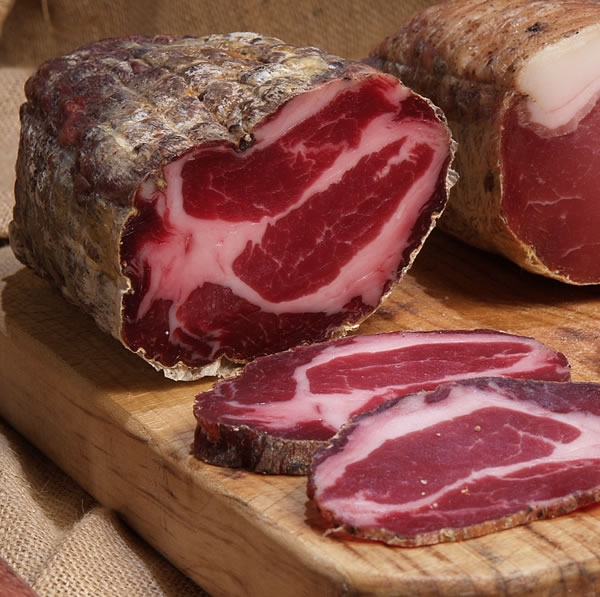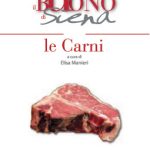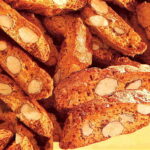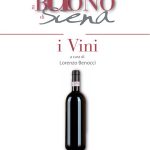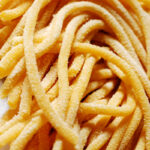Buristo
Produced in almost the entire region and in the province of Siena, the buristo is a cylindrical-shaped salami having an average standard weight from 700g. to 1.5 kg. Characterized by a typical dark red colour, it has different names according to the production area (Mallegato pisano, Mallegato livornese, Sanguinaccio), although the production techniques are basically the same in the whole region. The pork blood is mashed together with fat cubes (or so-called pork “ciccioli”), salt, pepper, spices and sometimes cinnamon and breadcrumb. Wrapped in the guts of the same pork, (previously cooked in the water), the product is left to cool in fresh but not too damp rooms. The production of buristo is carried out from October to February.
Capocollo
Produced in all of Siena’s province, the Sienese Capocollo, also called “Finocchiata”, has a long cylindrical shape having an aroma and a taste recalling the spices used for its production. The capocollo is manually salted by adding aromas, pepper and other perfumes. After being salted again, the product is packed by wrapping it with a net or in straw paper. Its maturation can last from thirty to sixty days.
Finocchiona
Cold-cut approximately produced in all of Tuscany’s area, the finocchiona has a cylindrical shape and a colour ranging from a rose to a dull rose with rather sanguine shades. Its taste and scent are intense and have a distinctive taste of fennel (from which in fact the cold-cut gets its name). The preparation includes a selection of pork meats which are then mashed by adding salt, pepper, garlic, red wine and wild fennel flowers. Then the mix is wrapped in pork guts (previously boiled), then tied and dressed. The maturation of this preparation can last from one to two months and must be done in aired rooms sheltered by the external climate, since the latter has a notable influence on giving this cold-cut a special taste and a really typical flavouring.
Sienese Cinta ham
Produced in Siena and in all its province (sometimes also known as Chianti Prosciutto) having a typical “cinta” pork meat (the black and white striped pig typical of this territory), its flesh has vivid red tending to have a dull shade and a very low percentage of fat under its skin, having a colour tending to white with light rose grains. Its taste is very strong, a bit stronger than the one of a “normal” Tuscan ham. The peculiarities of the Sienese “cinta” ham are given by its raw material, exclusively obtained by the butchering of ”pure” Sienese “cinta” bread meat, which is made between the twelfth and the fifteenth year of age of the animal. The preparation technique, which is rather typical, includes a salting on wooden boards and a subsequent process in which the salt is slowly taken away. Then the ham rests in refrigerating rooms and after this, it’s garnished with pepper. Typical are also the wooden frames in which the product is left to season.
Tuscan Ham – DOP
About the Dop Tuscan ham’s raw material, the pigs must be bred and butchered in those regions traditionally adapt to swine breeding (Tuscany, Emilia Romagna, Lombardy, Lazio, Umbria, Marche), but the product working must be done inside the boundaries of the region Tuscany. The finished product has a somewhat round shape, being elongated in the upper part. The slice is vividly red-coloured, with darker or lighter shades, according to the seasoning. The presence of intramuscular fats is poor. The taste is delicate, with harmonious level of taste and a typical flavour coming from the elaborate seasoning. The most appropriate adjective for the Tuscan Ham is tasty, but the taste is just partly due to salt, since the use of typically Tuscan essences and natural aromas is fundamental, just as garlic, rosemary, juniper, myrth. The production process starts with the isolation of the thighs and the trimming of the arch. A dry salting follows, by means of sea salt, pepper, natural aromas and spices of vegetable origin (garlic, rosemary, juniper and myrth, just as pointed out). As it is salted, a seal is applied, with the month marking the start of the seasoning (which is one year long), printed on it. At the end of this process a fire mark certificates the qualification of the product, which now has the organoleptic features of the production regulation.
Sienese “cinta” Salami
It’s quite a big-sized salami, having a weight from 500g. to 2Kg. Produced in all of Siena’s province, it is dark red, has a strong thickness and an intense scent. Its production technique is particular, mad by using pure breed “Cina Senese” meats, butchered when the animal is between twelve and fifteen months. The lean parts, finely minced, and the fat, chopped in small cubes, are mashed with salt, grained pepper, red wine, garlic and sugar. Subsequently the mix is wrapped in beef or pork’s guts. A period of seasoning varying from twenty days to twelve months follows, the time depending on the weight. For the biggest salamis, after the fourth month of maturation, an external treatment by using a semi-worked fat follows: this permits a longer time of seasoning and gives the final product a more intense taste.
Tuscan Salami
The Tuscan salami is produced in almost the whole region, it’s a cold-cut which has extraordinary typical qualities of taste and flavour. It’s dull red but the colour changes in different areas of production. The preparation process consists of using a finely minced swine meat, matched to a third of grass chopped in small cubes. All this is treated, mashed with salt, pepper, garlic and marinated with wine. Then it’s wrapped in natural guts, and left to mature for a few days (during which it’s dried near fire), before being seasoned for about six months in cellar.
Wild boar sausage
It’s a cold-cut typical of the provinces of Siena and Grosseto, having a definite brown shape with reddish shades. The sausage is obtained from wild boars by mixing, working and wrapping swine and wild boar meats, by adding spices such as pepper and chilli pepper. The preparation way has always been the same, consisting in a former mix to which spices and swine wrapped guts are added. Then the product is left to rest in proper rooms. Its taste is particularly intense.
Prodotto realizzato all’interno del Progetto di Valorizzazione dell’agroalimenatare senese 2009 promosso dalla CIA di Siena e cofinanziato dalla CCIAA di Siena.
CLICK HERE FOT THE ITALIAN VERSION
CLICK HERE FOR PHOTOS
Informazione pubblicitaria










